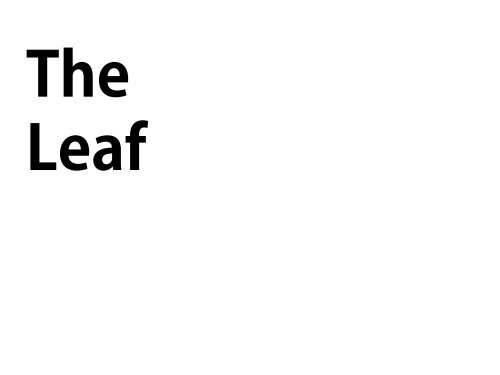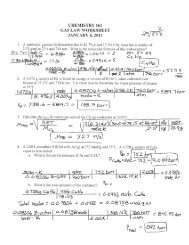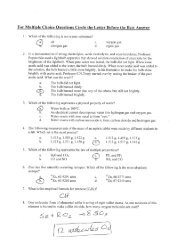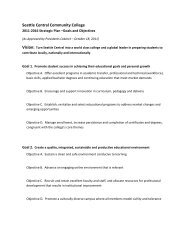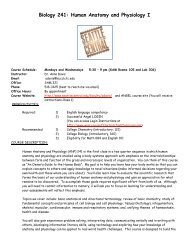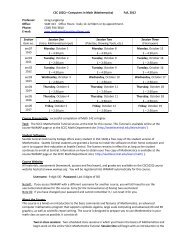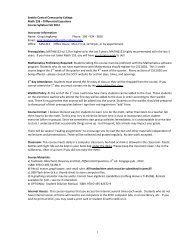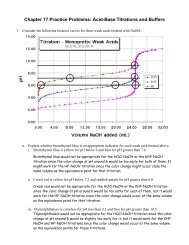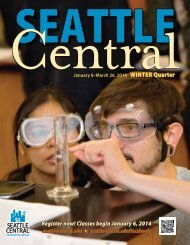LEAVES - PPT
LEAVES - PPT
LEAVES - PPT
Create successful ePaper yourself
Turn your PDF publications into a flip-book with our unique Google optimized e-Paper software.
The<br />
Leaf
The Plant Body: Leaves<br />
• FUNCTIONS:<br />
– Leaves are the solar<br />
energy and CO 2<br />
collectors of plants.<br />
– In some plants,<br />
leaves have special<br />
functions.
External Anatomy of a Leaf
Types of Leaves<br />
• Leaves can be simple or compound.<br />
– Simple leaves - With a single blade<br />
– Compound leaves - Blade divided into leaflets<br />
• Pinnate compound leaves - Leaflets in pairs<br />
along petiole (pinna: latin for feather)<br />
• Palmate compound leaves - All leaflets<br />
attached at same point at end of petiole.
Pinnately & Palmately Compound Leaves
Venation<br />
• Monocots - parallel venation<br />
• Dicots - netted or reticulate venation.<br />
Parallel<br />
venation<br />
Reticulate venation
Venation<br />
Reticulate<br />
Venation
Phyllotaxy<br />
• Leaves are attached to stems at nodes.<br />
– Phyllotaxy - Arrangement of leaves on stem<br />
• Alternate - One leaf per node<br />
• Opposite - Two leaves per node<br />
• Whorled - Three of more leaves at a node<br />
Alternate<br />
Opposite<br />
Whorled
Phyllotaxy - Arrangement of leaves on a stem
The Epidermis of Leaves<br />
• Stomata – pores<br />
– allow gas exchange<br />
– bordered by two<br />
guard cells<br />
• Trichomes – leaf<br />
hairs<br />
– functions: deter small herbivores,<br />
reflect sunlight, reduce air flow.
Representative scanning electron microscopy images of trichomes on plants.<br />
Dai X et al. Plant Physiol. 2010;152:44-54<br />
©2010 by American Society of Plant Biologists
Guard Cells
Leaf – Internal Anatomy
Mesophyll and Veins<br />
• Photosynthesis takes place in the mesophyll<br />
between the two epidermal layers.<br />
• Palisade Mesophyll<br />
• Contain most of<br />
the chloroplasts<br />
• Spongy Mesophyll<br />
– Loosely arranged<br />
cells with air<br />
spaces
Sun v. Shade Leaves<br />
• Compared to sun<br />
leaves, shade leaves:<br />
– Tend to be larger<br />
– Tend to be thinner<br />
– Have fewer layers of<br />
palisade mesophyll<br />
– Have fewer<br />
chloroplasts<br />
Sun<br />
leaf<br />
Shade<br />
leaf
Leaves in Arid Regions<br />
• Arid regions have limited availability of water<br />
– Leaves reduce water loss:<br />
• Thick, leathery leaves<br />
• Fewer stomata or sunken stomata<br />
• Succulent, water-retaining leaves, or no leaves<br />
• Abundant trichomes
Leaves of Aquatic Plants<br />
• Leaves of Aquatic Areas<br />
– Less xylem and phloem<br />
– No palisade and spongy, just mesophyll.<br />
– Large air spaces
Needles and Spines<br />
Tendrils<br />
Colorful<br />
Bracts
Insect Trapping Leaves<br />
• Carnivorous Plants<br />
– Why are they<br />
green<br />
– Why do they trap<br />
insects<br />
Sundew<br />
Pitcher plant<br />
Venus’s<br />
Flytraps
Deciduous Plants & Abscission<br />
• Deciduous plants drop<br />
their leaves in fall<br />
– build new leaves each<br />
year.<br />
– Why not tropical plants
Autumnal Change in Leaf Color<br />
• Leaves contain several types of pigments:<br />
– Chlorophylls - Green<br />
– Carotenoids – Yellow/Orange<br />
– Anthocyanins (red or blue) may also be present<br />
– In fall, chlorophyll is no longer produced and<br />
the existing chlorophyll is broken down by the<br />
plant<br />
– Other pigment colors are revealed.
Abscission<br />
Process by which leaves are shed<br />
• Changes in the abscission zone (near the base<br />
of the petiole)<br />
– Protective layer<br />
o<br />
Cells coated with<br />
suberin (wax)<br />
o<br />
stops water loss<br />
– Separation layer<br />
o<br />
Pectin in the cell wall<br />
is broken down by<br />
enzymes


